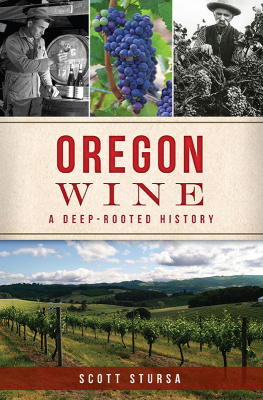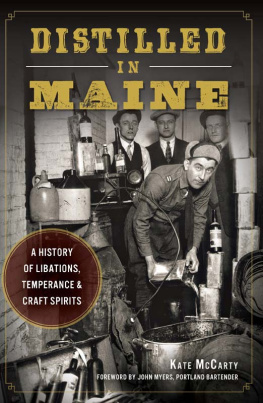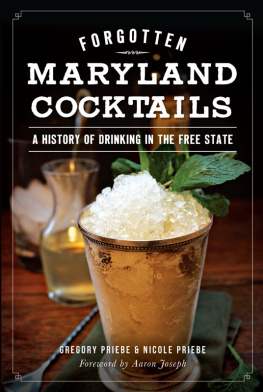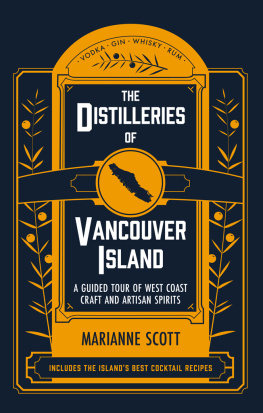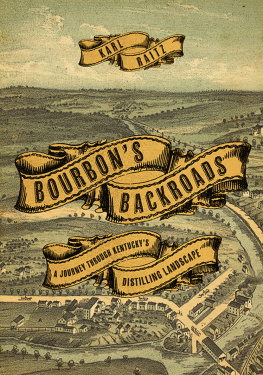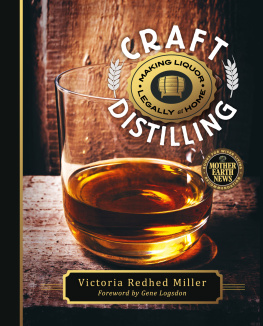Published by American Palate
A Division of The History Press
Charleston, SC
www.historypress.net
Copyright 2017 by Scott Stursa
All rights reserved
First published 2017
e-book edition 2017
ISBN 978.1.43965.949.6
Library of Congress Control Number: 2016953501
print edition ISBN 978.1.46713.772.0
Notice: The information in this book is true and complete to the best of our knowledge. It is offered without guarantee on the part of the author or The History Press. The author and The History Press disclaim all liability in connection with the use of this book.
All rights reserved. No part of this book may be reproduced or transmitted in any form whatsoever without prior written permission from the publisher except in the case of brief quotations embodied in critical articles and reviews.
To Kathy I still dont know why she puts up with me.
FOREWORD
Well Portland, Oregon, and sloe gin fizz
If that aint love then tell me what is
Well I lost my heart it didnt take no time
But that aint all. I lost my mind in Oregon.
Loretta Lynn
Distilling attracts a certain kind of person. I wont use the word crazy, but lets just say crazy isnt a disqualifier.
Good distillers are willing to spend long hours doing hard, expensive, messy work on the off-chance that the result, years later, will be something that brings a bit of pleasure to other people. Its not a profession for everybody, but for some, its more than a jobits a calling.
Right now, Oregon is home to a lot of those people. Over the past fifteen years, the craft distilling industry has grown so dramatically that youd be forgiven for thinking it sprang forth, fully formed, from the turn of the twenty-first century like Athena did from Zeuss head.
In reality, Oregon distillers have been engaged in that most mundane of alchemies, turning grain and fruit into alcohol, for hundreds of years. In the early days of Oregon history, local distilleries were commonplace, and small-scale agricultural distillingusing stills to preserve surplus crops, for pleasure and profitwas just common sense. Before railroads, the bestsometimes the onlyway to get whiskey was to make it yourself.
The giant eraser of Prohibition not only wiped most of those small distilleries off the map, it wiped our collective consciousness clean of the memory of regional distilling. Thats our loss. The diversity of regional distilling, once alive and well, enlivened our communities with local flavors, local color and, yesoh, yessome seriously entertaining local personalities. Horse thieves, corrupt sheriffs, lowlife saloonkeepers, tax dodgerstheyre all here.
Fortunately, some of that diversity is coming back. Our current distillery landscape might confound a time traveler from 1955, but one from 1855 would feel right at home.
Scott Stursa puts the Oregon distillery boom into valuable perspective with this rigorously researched glimpse into our states boozy past, from the unscrupulous Hudsons Bay Company employee who flavored rum with a bit of grain and called it whiskeyits nickname, Blue Ruin, does seem more appropriateall the way through todays quality-obsessed entrepreneurs, making brandy one pear at a time. Its a spirited history thats simultaneously scholarly and lively, grounded and opinionated, all leavened with a touch of dry humor and an obvious delight in the quirky details of the historical record.
Its a good time to be a drinker in Oregon. Is it a good time to be a distiller? Perhaps. Honestly, it has never been easy. Take the Portland Distilling and Cattle Feeding Company. Built in 1891, it was totally destroyed not once but twice in the next three years: burned to the ground in 1892 and then swept away in the 1894 floodtwelve employees and all. Its enough to make todays tribulations with federal labeling legislation and facilities regulations seem minor by comparison. Instead of glossing over the challenges, Stursa confronts them head on, offering a no-BS glimpse into the trials of taking up the mash paddle.
Running a still connects you to a fraternity that spans eons. When todays distillers make a heads cut, tighten a barrel hoop or adjust the pH of their mash to accommodate a surprisingly acidic wild yeast on the skins of the plums they harvested from a friends farm, theyre walking in a well-worn set of footstepsfootsteps that trace the many paths Oregonians walked before they got here: from Germany, from Boston, from Georgia, from England and from farther afield.
Between then and now, the colorful characters, the entrepreneurs, the bon vivants, the misfits and, yes, the swindlers are the same. Times may have changed, but there has always been something about Oregon that attracts distillers. Its one of the only states able to grow grain and fruit with equal faculty, and abundant pure water sources from Cascade Mountain snowpack, a flowing network of rivers and our famous rains have kept mash tuns and worm tubs full for generations
Plus, I think theres something special in Oregon thats long been a kind of psychic Bat-Signal for the fanatical, the hyper-focused, the dream-chaser, the geek, the oddballthe kind of person who makes a good distiller, craziness and all. Distilled in Oregon brings all those characters together in one place for the very first time, and youre invited to the party.
MARGARETT WATERBURY
Editor
Edible Portland Magazine
ACKNOWLEDGEMENTS
Thank you to the staff at the Oregon State Archives, the Oregon Historical Society, the Southern Oregon Historical Society, the Columbia Gorge Discovery Center, the Polk County Historical Society and the National Archives in Seattle.
Thank you to Steve McCarthy and all the other Oregon distillers who shared their stories with me.
Thank you to Elizabeth Dameron, great-granddaughter of one of the founders of Hood River Distillers, for the information she provided and for permission to use her photographs.
Thank you to Christie Scott and Joy Spencer of the Oregon Liquor Control Commission.
Thank you to all the friends who supported me and, in particular, to Lyn Larson for her help in editing the draft manuscript.
And thank you most of all to my wife, Kathleen, for believing in me and for excusing me from numerous household duties so that I could finish this by deadline.
INTRODUCTION
THIS BOOK IS OBSOLETE!
OK, just the final chapter, which attempts to provide a brief description of all the distilleries that have opened in Oregon since 2009, is outdated. Between the time that this book was submitted to the publisher and the time it appeared in print, there will have been at least four more distillery openings, possibly morenot to mention all the distilleries that will open in the years following publication. Ill try to keep track of them and post updates to www.distilledinoregon.com.
When I first conceived of this book (in late 2011), my initial thought was to publish a guide to the currently operating distilleries in the state, rather like a winery guide. However, with only about twenty distilleries operating at the time, it would have made for a slim book. I decided instead to do a full historical treatment, reaching back to the 1830s. The result was a lot of time spent at historical archives, and by the time I finished (in August 2016), there were over sixty distilleries in Oregon, more than enough for a guide.


